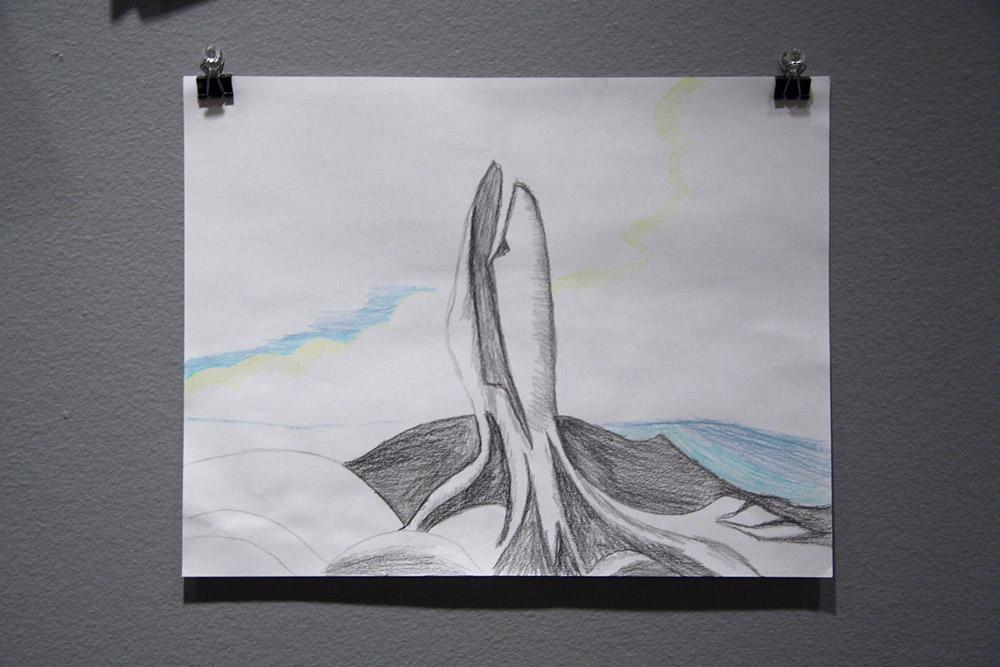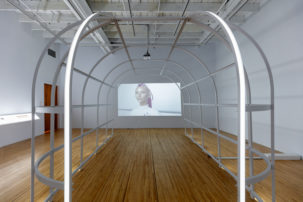Named after a New York bar frequented by the Abstract Expressionists, Lethbridge’s Cedar Tavern Singers have become known for light, poppy, funny songs about an unlikely subject: the art world in general and (even more unlikely, perhaps) the Canadian art world in particular.
Since the band’s members Mary-Anne McTrowe and Daniel Wong met at the Banff Centre in 2006, CTS (aka Les Phonoréalistes) has crooned about various topics in this vein: East Coast art versus West Coast art, the challenge of talking about and making art, the history of the Mendel Art Gallery, and the thesis of MASS MoCA’s exhibition “Oh, Canada.”
In the first room of the Lethbridge duo’s current Carleton University Art Gallery exhibition, “Art Snob Solutions, Phase III: At the Hundredth Meridian,” viewers encounter a flatscreen TV playing a video for CTS’s new song “See You at the CUAG.” This ditty traces the history of the gallery from its proposal in 1970 to a 1980s collections bequest to its 1992 opening. In the video, McTrowe, Wong and CUAG educator Fiona Wright playfully dance, sing and strum ukuleles outside the gallery entrance.
“See You at the CUAG” is part of the four-song EP At the CUAG, which also features two songs on works in the CUAG collection and a track about former CUAG director Diana Nemiroff’s controversial acquisition of Jana Sterbak’s Vanitas at the National Gallery in 1991.
One of the best things about the EP is its cover, where McTrowe and Wong, in parkas, plaid shirts and toques, ape the McKenzie Brothers—but with paint tubes in hand rather than stubby-bottle beers. (“Like, definitely disarming and smile-worthy, eh?”) Some of McTrowe and Wong’s plaid-and-toque-heavy performance costumes also hang nearby.
The second room of the show features works a bit more interactive in nature.
For Draw Your Favourite Canadian Work of Art and Win Big!—my highlight of the exhibition—CTS did an open call for anybody to submit a drawing of, yes, their favourite Canadian artwork to be entered in a draw for CTS swag. Hung salon-style on one wall, these drawings do something a lot of artworks don’t: they make visible people’s thoughts, feelings and memories about art, offering a miniature survey of the way Canadian art might rest in and resound through certain parts of the collective national psyche.
Pencil-crayon reproductions of Joyce Wieland’s O Canada were submitted by multiple people for this project, as were redos of Lawren Harris’s North Shore, Lake Superior and versions of Kenojuak Ashevak’s owls. Also among the array is a Sharpie-ish doodle of Valérie Blass’s L’Homme Souci; a lace-framed depiction of Terence Koh’s gold-plated feces; a felt-tip marker take on one of Greg Curnoe’s bicycle wheels; a steno-pad sketch of General Idea’s Playing Doctor; a frame-by-frame drawing of an excerpt from Michael Snow’s text-film So Is This; a blind-contour exercise based on one of Shary Boyle’s porcelain figurines; a rendition of Douglas Coupland’s pixelated-Orca sculpture near Vancouver’s convention centre; and a drawing of one of Karim Rashid’s iconic Umbra Garbo garbage cans.
At a nearby table supplied with pencils and paper, visitors can contribute to this project and to another one in the room: Describe Your Favourite CUAG Exhibition. In Describe, feedback cards from gallery-goers advocate for the recent “Truly Canadian: Inuit Art and National Identity” as well as for the touring Colin Campbell exhibition “People Like Us,” among other shows. Comment books from the CUAG archives accompany.
The final work displayed in the show’s second room is the $10 activity book Let’s Learn About Canadian Art with the Cedar Tavern Singers. Its retro, tongue-in-cheek exercises include “Connect the dots to see Eric Cameron’s thick painting,” “Fastwürms need matching hats for their performance. Which two are the same?” and “Istvan Kantor wants to do a surprise action! Help him draw a blood X below!” Like CTS’s songs, these pages reframe and revamp arcane moments, facts and details of the Canadian art world into popular, low-fi, introductory format.
The final room of the show features a high-art-meets-pop-cult mashup of a different sort: a perfume based on the plein-air painting practice of iconic Canadian artists like the Group of Seven. Called Terre Sauvage, the bright-pink perfume is packaged for display in maple-leaf-shaped bottles. A tester releases a strong (and in fact, difficult to shake) spruce-pine smell—an allegory, perhaps, for the lingering, permeating way that the G7’s legacy persists in the Canadian art world, or at least in popular perceptions thereof.
Overall, CTS’s work offers a refreshingly unpretentious approach to what many publics experience as one of the most snooty, exclusive and high-falutin’ social spheres around: the art world. (That’s not to say there aren’t lots of nice people in the art world; it’s just that they might often use a lot of terminology and processes that tend to shut out, or turn off, the unconverted.) For persisting in this effort of friendliness, fun and education—or, in their titular parlance, “Art Snob Solutions”—I salute CTS. McTrowe and Wong’s spirit is a rare one on the exhibition circuit, Canadian and otherwise.
However, I remain cautious about CTS’s EP liner-notes statement that “through this juxtaposition of esoteric art historical knowledge and popular culture we attempt to covertly expose this information to a wider audience.” My caution emerges from the fact that as much as I appreciate CTS’s efforts, I am an art insider—one of the converted. As a thank-you wall text indicates, many of the people who submitted to Draw Your Favourite Canadian Work of Art and Win Big! are also of this ilk. And given that most of CTS’s performances of late are in art galleries and that their recordings and activity books are distributed via similar institutions, it seems they may have more “insider” appeal than “wider audience” effect.
(To be fair, the group does distribute songs on MySpace and McTrowe has a feed on YouTube as well, so I can recognize that they are trying to get beyond the usual art-world bounds. I am assuming that the online audience continues to be mainly those already in the know.)
Nonetheless, there is something about CTS’s work—particularly the drawing project and comments project at CUAG—that I find quite touching. Through disarmingly simple gestures, CTS invites us to examine and explore something that can actually be quite complicated and unspoken: our relationships and experiences, whether collective or individual, to Canadian art and its subcultures. At my most optimistic, I would hope that CTS’s works—by gently and absurdly highlighting the art world’s popular blind spots—may also encourage art insiders to consider sharing those aesthetic and affective relationships and experiences with the many publics who may not (at this time, at least) feel welcome or entitled to participate in the same way.









